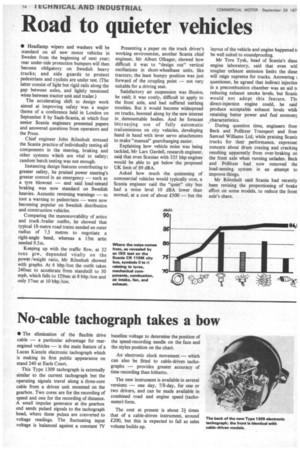Road to quieter vehicles
Page 356

If you've noticed an error in this article please click here to report it so we can fix it.
• Headlamp wipers and washers will be standard on all new motor vehicles in Sweden from the beginning of next year; rear under-ride protection bumpers will then become obligatory on Swedish heavy trucks; and side guards to protect pedestrians and cyclists are under test. (The latter consist of light but rigid rails along the gap between axles, and lightly tensioned wires between tractor unit and trailer.) The accelerating shift to design work aimed at improving safety was a major theme of a conference held in London on September 8 by Saab-Scania, at which four senior Scania engineers presented papers and answered questions from operators and the Press.
Chief engineer John Riinnhult stressed the Scania practice of individually testing all components in the steering, braking and other systems which are vital to safety; random batch testing was not enough.
Instancing design features contributing to greater safety, he praised power steering's greater control in an emergency — such as a tyre blowout — and said load-sensed braking was now standard on Swedish heavies. Acoustic reversing warnings — to toot a warning to pedestrians — were now becoming popular on Swedish distribution and construction vehicles.
Comparing the manoeuvrability of artics and truck /trailer outfits, he showed that typical 18-metre road trains needed an outer radius of 7.5 metres to negotiate a right-angle bend, whereas a 15m artic needed 9.5m.
Keeping up with the traffic flow, at 32 tons gtw, depended vitally on the power /weight ratio, Mr Ronnhult showed with graphs. At 6 bhp /ton the outfit takes 240sec to accelerate from standstill to 50 mph, which falls to t29sec at 8 bhp /ton and only 57sec at 10 bhp /ton. Presenting a paper on the truck driver's working environment, another Scania chief engineer, Mr Albert Olhager, showed how difficult it was to "design out" vertical oscillations in short-wheelbase units, like tractors; the least bumpy position was just forward of the coupling point -not very suitable for a driving seat.
Satisfactory air suspension was illusive, he said; it was costly, difficult to apply to the front axle, and had suffered teething troubles. But it would become widespread on trucks, boosted along by the new interest in _ demountable bodies. And he forecast liter easing use of fully automatic transmissions on city vehicles, developing hand in hand with lever servo attachments to make "manual" gearchanging easier.
Explaining how vehicle noise was being tackled, Mr Lars Gardell, research engineer, said that even Scanias with 335 bhp engines would be able to get below the proposed UK limit of 89 dBA.
Asked how much the quietening of commercial vehicles would typically cost, a Scania engineer said the "quiet" city bus had a noise level 10 dBA lower than normal, at a cost of about £500 — but the layout of the vehicle and engine happened ti be well suited to soundproofing.
Mr Tore Tysk, head of Scania's diese engine laboratory, said that even witl tougher exhaust emission limits the diese will reign supreme for trucks. Answering questioner, he agreed that indirect injectica in a precombustion chamber was an aid t( reducing exhaust smoke levels, but Scanit would not adopt this feature. Thl direct-injection engine could, he said produce acceptable exhaust levels whit( retaining better power and fuel econom3 characteristics. During question time, engineers froir Beck and Pollitzer Transport and from Samuel Williams Ltd, while praising Scanie trucks for their performance, expressed concern about drum crazing and cracking resulting apparently from over-braking on the front axle when running unladen. Beck and Pollitzer had now removed the load-sensing system in an attempt to improve things.
Mr R6nnhult said Scania had recently been revising the proportioning of brake effort on some models, to reduce the front axle's share.
































































































































































































































































































































































































































































































































